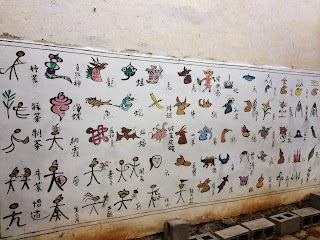The town of Lijiang, which I have just visited, has served as the cultural center of the Naxi people for
centuries. The Naxi are one of South-Western China's many ethnic minorities. The most
curious thing about their culture is their alphabet, known as the Dongba script. It is literally made up of pictures. Their script is claimed to be
the last truly pictographic writing system still in use anywhere in the
world (the Chinese script isn't really pictographic, or at least most of
it isn't).
In Lijiang's old city, a big thing is now made of the Naxi script for the benefit of tourists. A lot of shop signs in Lijiang sport the Naxi pictographs above the Chinese characters. A number of syllabaries of Naxi letters can also be seen on the walls of the Old Town, like the one I photographed below. Most of the characters bear an obvious resemblance to their meaning, and some are pretty amusing.
Of course, just like with a lot of things in China, reality is a bit more complicated than the myth. The Dongba script was developed in the seventh century, and it includes around a thousand pictographs. It was only ever used by the Naxi priests for the recitation of ritual texts, and it is unsuitable to represent the Naxi language on its own. It is in fact supplemented by a phonetic syllabary, the Geba script.
What's more, the Naxi language has never been written very extensively, and nowadays all literate Naxi read and write entirely in Chinese for practical purposes. After the Maoist takeover, the Dongba script was condemned as a sign of religious superstition and discouraged. During the Cultural Revolution, many old manuscripts were destroyed.
Nowadays however, the government encourages the use of the ancient script in Naxi areas, at least symbolically. Government institutions in Naxi villages have signs written in both Chinese and Naxi characters. You can also sometimes see the red couplets the Chinese traditionally paste around their doors with writing in the Naxi language (as in the photo above).
The spoken Naxi language is still used by about 300,000 people (an estimated 100,000 are monolingual), and is in no danger of dying out. On the streets of Lijiang I saw old women wrapped up in traditional clothing who were conversing in a language which definitely wasn't any form of Chinese, and I suppose must have been Naxi.
In Lijiang's old city, a big thing is now made of the Naxi script for the benefit of tourists. A lot of shop signs in Lijiang sport the Naxi pictographs above the Chinese characters. A number of syllabaries of Naxi letters can also be seen on the walls of the Old Town, like the one I photographed below. Most of the characters bear an obvious resemblance to their meaning, and some are pretty amusing.
 |
| Every Dongba pictograph is accompanied by a Chinese translation underneath. |
Of course, just like with a lot of things in China, reality is a bit more complicated than the myth. The Dongba script was developed in the seventh century, and it includes around a thousand pictographs. It was only ever used by the Naxi priests for the recitation of ritual texts, and it is unsuitable to represent the Naxi language on its own. It is in fact supplemented by a phonetic syllabary, the Geba script.
What's more, the Naxi language has never been written very extensively, and nowadays all literate Naxi read and write entirely in Chinese for practical purposes. After the Maoist takeover, the Dongba script was condemned as a sign of religious superstition and discouraged. During the Cultural Revolution, many old manuscripts were destroyed.
 |
| A door in Lijiang with the typical Chinese red couplets pasted around it, written in the Dongba pictographs. |
Nowadays however, the government encourages the use of the ancient script in Naxi areas, at least symbolically. Government institutions in Naxi villages have signs written in both Chinese and Naxi characters. You can also sometimes see the red couplets the Chinese traditionally paste around their doors with writing in the Naxi language (as in the photo above).
The spoken Naxi language is still used by about 300,000 people (an estimated 100,000 are monolingual), and is in no danger of dying out. On the streets of Lijiang I saw old women wrapped up in traditional clothing who were conversing in a language which definitely wasn't any form of Chinese, and I suppose must have been Naxi.
 |
| An inn in Lijiang with Dongba pictographs above the Chinese characters. |
No comments:
Post a Comment